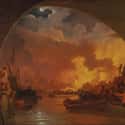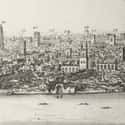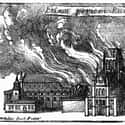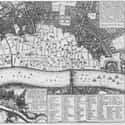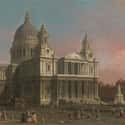-
(#9) The Government Instituted New Building Regulations Over Width Of Streets And Height Of Secular Buildings
The London Building Act of 1667 shaped London's look for centuries. The act banned the timber facades and thatched roofs that had fueled the blaze. It also regulated the width of streets and ordered some streets straightened to make it easier to protect the city from fire. Londoners could no longer build timber structures six stories high, nor could upper stories jut out over the ground floor.
The Act represented the first time England allocated money for surveyors, who helped enforce the regulations. These men became the first building control officers in history.
-
(#8) Physician Nicholas Barbon Set Up The First Insurance Company To Capitalize On The Fire
The Great Fire created business opportunities for Londoners, including Physician Nicholas Barbon who capitalized by creating the first insurance company. After so much property loss and disputes over who would pay, Barbon saw he could insure people's homes from future fires and make a profit. Like modern insurance companies, Barbon's company, Fire Office, promised to pay back damages from future fires for those who paid for an insurance policy. He used the Great Fire as advertisement by asserting that if those who lost their homes in the fire had an insurance policy their losses would have been compensated.
Unlike modern insurance companies, however, Fire Office handed out fire marks to policyholders. If a fire broke out, the company sent out private fire brigades to protect homes that displayed the fire mark. If they didn't see the correct fire mark, the brigades left the building to burn.
In the aftermath of the fire, Barbon also bought up land and became one of the city's most prominent builders.
-
(#2) 65,000 Homeless People Dispersed To Villages Around The Area, While Rent In London Skyrocketed
The fire completely burned 80% of the area within London's medieval walls, leaving behind only a few stone ruins and left at least 65,000 people homeless. In the early days after the fire, when the ground in many places was still too hot to walk on, displaced Londoners camped in fields outside the walls. Soon, many traveled to villages outside of the capital or other parts of the city.
The housing shortage caused rent prices in London to rise exponentially. Within only days, leasing costs rose about 200%, but within two weeks, houses grew 10 times more expensive. Rental and leasing prices remained high through 1668, but even though the city was expensive, many merchants and tradesmen were willing to pay these extraordinary prices.
-
(#7) The Fire Of London Disputes Act 1666 Introduced A Fire Court Whose Entire Role Was To Settle Property Disputes
The Great Fire burned more than 13,000 homes, 87 parish churches, and monumental buildings like the Royal Exchange and St. Paul's Cathedral. Overall, the fire caused an estimated £10 million in damages, which was staggeringly large compared to the city's estimated annual income of £12,000.
England quickly convened a fire court to settle property disputes. The Fire of London Disputes Act set up a fire court that heard disagreements between landlords, tenants, and other occupants of the burned buildings and declared that many homeowners must still pay rent on burned and uninhabitable homes.
-
(#12) Medieval London Was Rebuilt In Brick And Stone
Within four years of the fire, Londoners had rebuilt 6,000 houses. But they looked different from the pre-fire homes. Medieval London was built from wood and thatch, but after the Great Fire, Under the Rebuilding Act, Londoners were required to build new homes from brick and stone. The Act declared, "No man whatsoever shall presume to erect any house or building, whether great or small, but of brick or stone." Furthermore, rather than pitch roofs, which helped spread the fire, new roofs were required to be made from tiles.
The new homes were also larger than their predecessors. Even though the city limited the height of new buildings to four stories, rich merchants snatched up large plots to build grand homes.
-
(#10) Christopher Wren Redesigned And Rebuilt The St. Paul Cathedral
The Great Fire burned St. Paul's Cathedral to the ground. Despite trying to save their own property, Londoners accidentally contributed to the building's destruction when they stacked their furniture inside the churchyard and added fuel to the fire.
Architect Christopher Wren, who had submitted improvement plans for the cathedral only weeks before the fire broke out, dedicated the rest of his life to rebuilding St. Paul's. By 1675, Wren had created new designs and begun digging new foundation. The dome was done in 1708, while the cathedral itself was finished in 1711.
Wren was buried in St. Paul's after passing in 1723. His gravestone reads, "If you seek his memorial, look about you."
In addition to St. Paul's, Wren oversaw the rebuilding of 51 parish churches.
New Random Displays Display All By Ranking
About This Tool
The Great Fire of London occurred from September 2nd to 5th, 1666. It was the worst fire in British history. It burned down many buildings, including St. Paul’s Cathedral, but this fire also cut off London since 1665. The plague problem. The cause of the fire was a fire in a bakery in Pudding Lane. A gust of wind quickly blew the flames across several narrow streets full of wooden houses, and the fire spread across the city.
The fire lasted for 4 days, including 87 churches, 44 companies, and 13,000 houses burned down. About one-sixth of the buildings in London, the largest city in Europe, was burned down. The random tool tells what happened in London after the fire.
Our data comes from Ranker, If you want to participate in the ranking of items displayed on this page, please click here.











